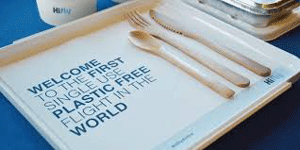The First Plastic Free Flight Recently Flew

For years, commercial airlines have been using vast amounts of single-use plastic items on their flights. Items, ranging from cutlery to bottles to containers, have taken up a large amount of waste produced on flights, as each person receives multiple plastic products that cannot be reused and must be disposed of in one way or another. According to the International Air Transport Association (IATA), the average passenger produces over 1.4 kilograms of waste per flight, which is just under 3 pounds of waste per person.
When the daily average of passengers on all flights equals an average of 8 million (according to IATA) that produces a conservative estimate of over 24 million pounds of waste being produced off of non-reusable plastic items per day, none of which can be used after the flights. Due to the great amounts of trash created on these flights as a consequence of using non-reusable plastic products, many have called for reform in the materials used on airlines, including the airlines themselves.
One such airline is Hi Fly, a Portuguese charter airline that recently took great strides in eliminating plastic from its flights. As a part of its goals (according to CTV News), it hopes to completely banish the material from its flights by the end of 2019, which is quite the feat. Already, its (and the world’s) first non-reusable-plastic free flight flew from Portugal to Brazil on December 26, 2018. On that flight, many changes were made to its materials, such as making the cutlery out of bamboo, easily compostable containers, and other changes to the components of their items.
In a statement to CTV, Hi Fly president and founder of the Mirpuri Foundation Paulo Mirpuri said, “We can no longer ignore the impact plastic contamination has on ecosystems, as well as on human health. We know, too, from the feedback we have received from client airlines and passengers, that it’s the right thing for the airline to be doing,” stating both the environment and the demands of the populous as leading factors that drive forward the need to become plastic-free.
With this momentous occasion, many other airlines are also beginning to make the transition to no-plastic flights, such as the Irish airline Ryanair and Air New Zealand, which will hopefully cause a chain reaction in order to greatly decrease the amount of waste produced through the plastic on airlines alone.
